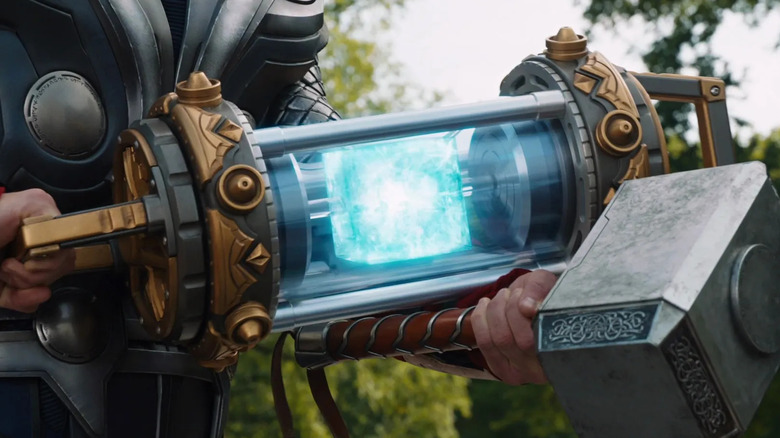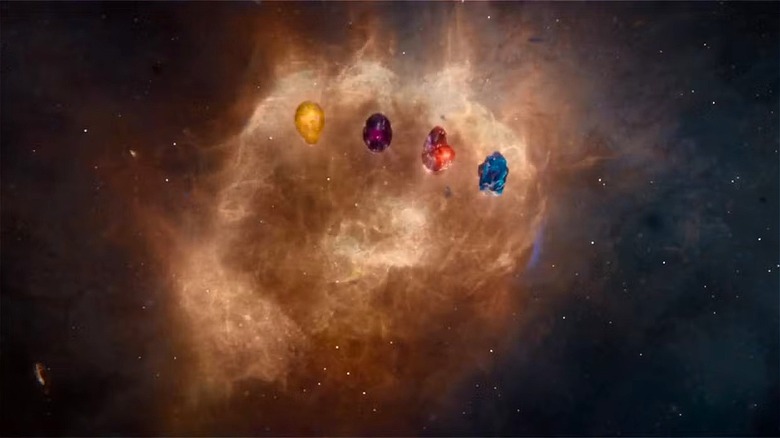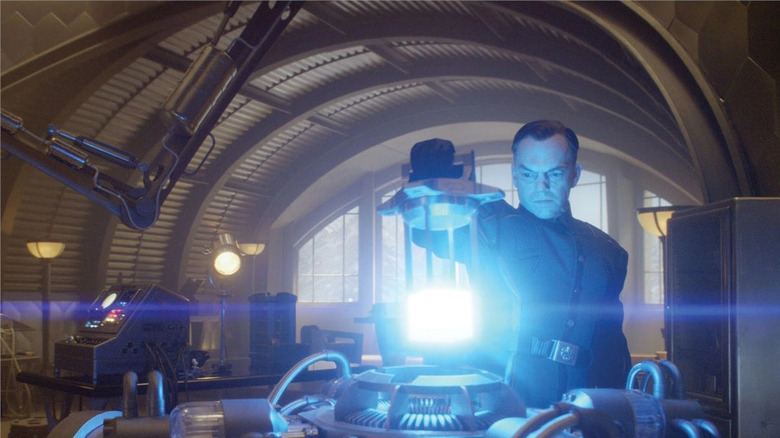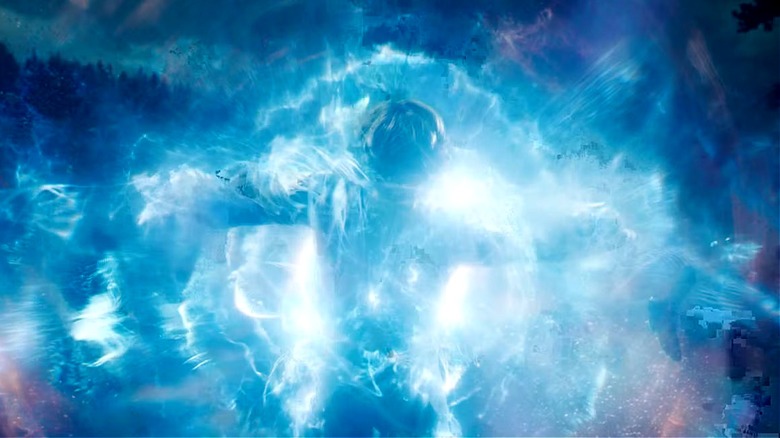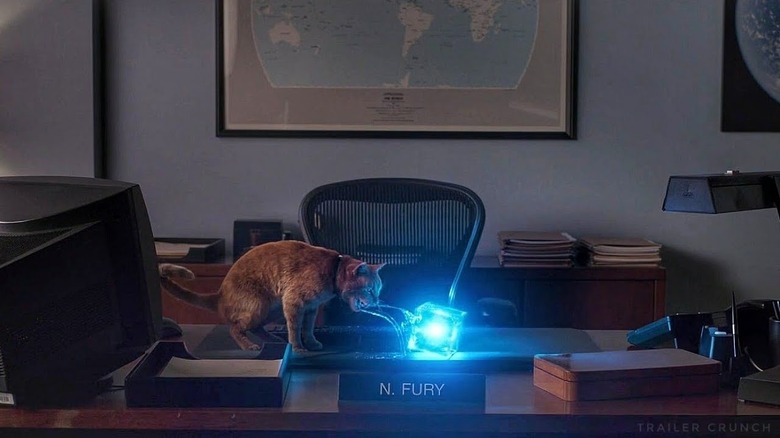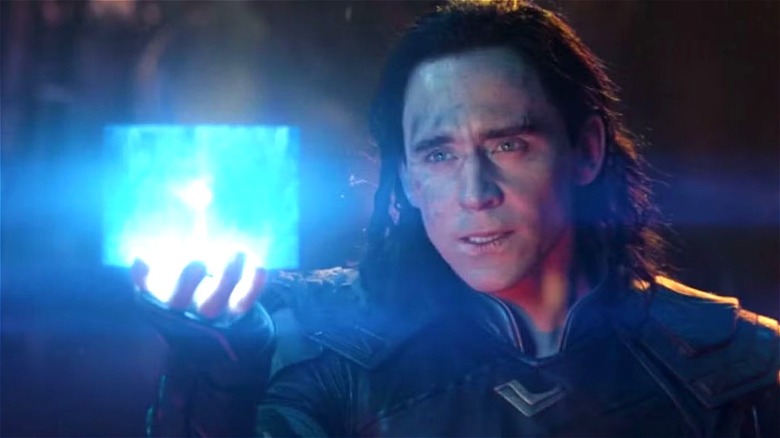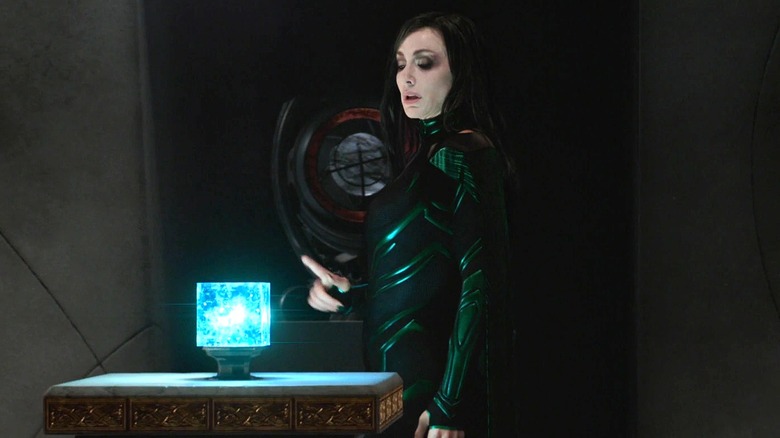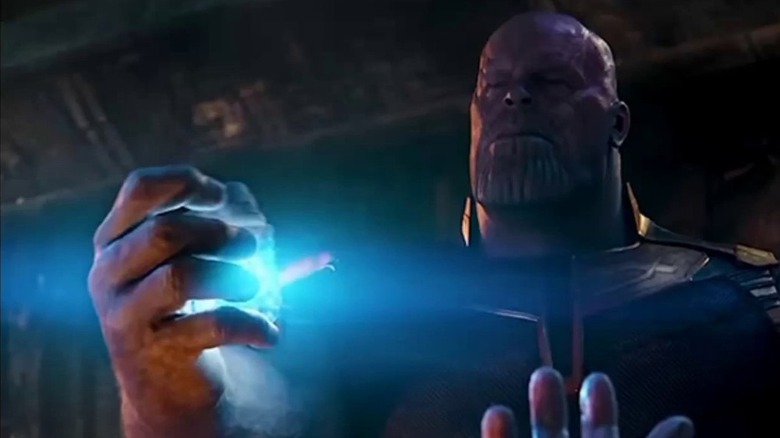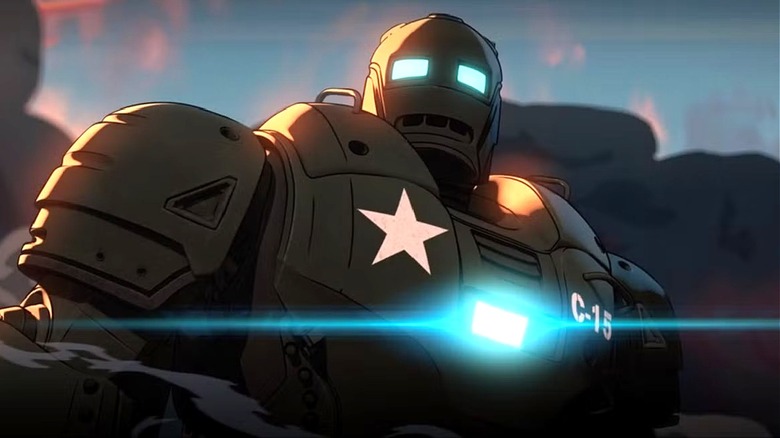The Tesseract's Timeline In The MCU Explained
The Marvel Cinematic Universe is filled with countless anomalies and curious items. Six of these come into focus during the Infinity Saga: namely, the story's titular gems. However, more than one of these start their journey in a non-stone state. The reality stone first shows up in a liquified form called the Aether; the Mind Stone is initially tucked into Loki's scepter. The Orb is encapsulated in a circular orb on an isolated temple on Morag. The Space Stone hides away in the Eye of Agamotto around Dr. Strange's neck. The Soul Stone is basically contained within the entire planet of Vormir (the geographic specifics are hazy here). And the Space Stone? It first shows up in the form of the Tesseract.
Also called the Cosmic Cube, or the "Cube" for short, this is the right-angled container that shows up repeatedly throughout the Infinity Saga before (spoiler alert!) Thanos arrives on the scene and breaks it like an empty Amazon box. Before that destructively liberating event, though, the Tesseract appears repeatedly in the larger MCU timeline, from Captain Marvel's story to Captain America's saga, the Avengers' epic first chapter, and more. Here is the full breakdown of the Tesseract timeline before its overpowered payload emerges to don the Dark Lord's Infinity Gauntlet in "Infinity War."
As a quick disclaimer, this will be the story of the Tesseract, not simply in the MCU but, specifically, in the primary MCU timeline since, well, tracing the prism of endless possibility that is the multiverse would quickly spiral out of control.
Early origins: where does the stone come from?
The MCU iterations of the Infinity Stones show up in random, often haphazard ways. However, they do have an (admittedly spotty) origin story. In the MCU, the Infinity Stones represent six singularities that appear in visible form after the universe is created. These become the Infinity Stones, including the Space Stone, which is further forged into its cubical containment, the Tesseract.
While the specifics of this creation process are a bit vague, it would appear that the singularities existed before the Big Bang and that the cosmic genesis perpetuates their shift into hardware form. From the jump, the gems are too overpowered for smaller beings to use, but bigger entities, like Celestials, Mad Titans, and god-like alien races, can wield them — and many do just that in their pursuit of either bettering their own ambitions, helping their kind, or taking down competitors.
This is what eventually leads the Tesseract to Asgard, where it becomes the jewel of Odin's treasure room as he fights to consolidate power across the Nine Realms. The one-eyed king locks the Cube away in his vault for a time before making a, well, let's say, an interesting move by bringing it to the sleepy Norwegian town of Tønsberg on the backwater planet of Earth. There, it's built into the wall of a temple to the Asgardian gods, where it lies dormant, though the locals worship it for its obvious power.
WW2 re-emergence: The Tesseract is discovered in Captain America
The Tesseract flies below the radar for centuries after it arrives on Earth. It isn't until Johann Schmidt (the man who later becomes Red Skull) arrives on the scene that it finally re-emerges, just in time for the greatest conflict Earth has ever seen: World War II.
Schmidt recognizes the Cube's incredible power and begins harnessing it to create superweapons for the Nazis. He also sets the stage for a HYDRA takeover that, powered by the Tesseract, would make Hitler and his minions look like chump change in the grand scheme of things. The only thing that stands in his way? The newly minted Steve Rogers, aka Captain America, and the Howling Commandos.
Cap resists Schmidt's overpowered shenanigans and, in true Cap style, takes the Red Skull down at the last possible second. The pair's final showdown takes place in February 1945 aboard the Skull's gigantic super bomber, the Valkyrie. In the airborne fight, Red Skull is transported to Vormir, where he proceeds to become the unexpected guardian of the Soul Stone. And the Tesseract? It falls to the floor of the plane in a superheated state, where it burns through the metal and plunges into the icy sea depths below.
From the sea to the air: The Tesseract is rediscovered in the ocean
Over the course of its Infinity Stone career, the Tesseract manages to spend its time in space, on land, at the sea bottom, and in blue skies. After plunging into the inky darkness of the oceans in 1945, it starts the brief aqueous portion of its Earth-borne tenure, one that abruptly ends when Howard Stark's oceanic search squad discovers the Cube while seeking the frozen body of Captain America.
At this point, the Tesseract finds itself in the custody of Stark, who studies the overpowered bauble before handing it over to the Strategic Homeland Intervention, Enforcement, and Logistics Division, aka S.H.I.E.L.D. The historically covert organization moves the Infinity Stone's still-square form to Camp Lehigh in New Jersey, where it is stored for decades.
This is where, in an alternate timeline, the stone is retrieved by Tony Stark and Steve Rogers during the "Avengers: Endgame" time heist. In the primary timeline, though, it survives in storage and becomes the focal point of Project P.E.G.A.S.U.S., a multi-agency effort by the U.S. government to harness the artifact's powers.
In the '80s, this garners the attention of a Kree scientist named Mar-Vell, who shows up disguised as a human, Doctor Wendy Lawson, and begins experimenting with different ways to harness the Tesseract's dimensional power. This includes building a Light-Speed Engine that allows the Cube to take to the skies. In 1989, Mar-Vell is killed and the Light-Speed Engine explodes, giving Carol Danvers the power of Captain Marvel in the process. In the wake of that incident, the Tesseract is moved to Mar-Vell's orbital laboratory, where it spends the next six years floating high above Earth.
S.H.I.E.L.D. stays Involved: The Tesseract returns to Nick Fury
"Captain Marvel" focuses on Carol Danvers' return to Earth in 1995. It's also arguably the movie in which the Tesseract plays the most critical role — at least as far as the good guys are concerned. Upon Danvers' return, the Tesseract surfaces again in Mar-Vell's space station, and, after the titular hero finds her new powers, she successfully handles the bad guys and wraps things up on a good note. The one missing piece of the puzzle? The Tesseract. However, in an end credit scene for that movie, we see that Danvers' cat-like Flerken, Goose (the creature responsible for Nick Fury's missing eye), has consumed the Tesseract — which it proceeds to barf up onto Fury's desk.
From there, the Cosmic Cube is once again in the hands of S.H.I.E.L.D., this time for nearly two decades. During that time, the agency's focus shifts from experimenting with and harnessing the Cube's energy to using it to create better defenses against extraterrestrial threats. This is partly thanks to the events of 2011's "Thor," which reveal the Asgardian interplanetary connections of Earth and expose the terrestrial planet's weak position in the universe. Eventually, Erik Selvig is brought in to help study the Space Stone and its tiny cubical, and the whole lot is moved to the Joint Dark Energy Mission Facility in the Mojave Desert. Clint Barton is assigned to the group to watch over the events, and things stay steady until 2012.
In the hands of a god: Loki comes looking the Tesseract
In 2012, Loki arrives on Earth, an Asgardian prince hellbent on revenge. Thanks to a clever retcon by Marvel, Loki is driven to antagonize the Avengers due to the Mind Stone-infused staff he wields. This leads him to unleash an all-out intergalactic war over the skies of New York City. And the tool he uses to spark this conflict over the Big Apple? The Tesseract.
"The Avengers" starts with Loki stealing the Cube from S.H.I.E.L.D.'s Mojave Desert hideaway. Later in the movie, he uses the cosmic artifact to open a portal that unleashes Thanos' Chitauri hordes over New York. The crux of the film comes when the Avengers manage to shut down the portal, saving New York City — and Earth — in the process. While the Tesseract is little more than a MacGuffin in the context of "The Avengers," as the Infinity Saga continues to unfold, it turns out that this busy period in the story's generally static journey actually plays a crucial role in setting the stage for its ultimate demise.
Back on Asgard: The Tesseract comes back home
At the end of "The Avengers," Thor escorts his brother and the Tesseract back to Asgard. While the former faces judgment, the latter is once again put to work in the hands of the gods. Of particular note, Heimdall uses its power to rebuild the Bifrost Bridge, which had been destroyed at the end of "Thor." After that, it is locked away in the Vault, claiming its position as the Jewel of Odin's treasure room once again.
It's worth pointing out that the decision to let one of the Infinity Stones go off-Earth puts Nick Fury in hot water with the World Security Council because, well, he let one of the Infinity Stones go off-Earth. (No surprise there.) In the end, however, the Cube's security gets an upgrade to a superior Asgardian prison, where it stays safely out of sight for half a decade.
Then, in 2017, the events of "Thor: Ragnarok" suddenly bring the Tesseract out of retirement again. The Cube initially makes a brief appearance early in that movie when the Asgardian prince's sister, Hera, notes that it is one of the few things in the vault that has genuine value. At the end of the movie, the Tesseract is presumably still in the vault when the entire realm of Asgard is destroyed in a fiery, Surtur-spawned apocalypse. But while it appears to spell the end for the Cosmic Cube, that isn't the case. It is spared for a tad longer — thanks to the God of Mischief.
The end of the Tesseract: Crossing paths with Thanos
Remember how we said this is the story of the Tesseract, not the Space Stone? Well, while the latter continues to play a major role in the MCU for a time, the aftermath of "Thor: Ragnarok" and the beginning of "Avengers: Infinity War" prove to be the abrupt ending of the Tesseract's timeline.
When Asgard's Ragnarok survivors bump into Thanos' forces, they quickly learn that their enemies are in search of the Space Stone. Why did they track them down to find it? Because Loki nicked the Cosmic Cube during the rapid evacuation of Asgard. This leads Thanos to hunt the god and his brother down, murder half of their people, and take the Tesseract by force.
It's at this point, in the opening moments of "Infinity War," that Thanos finally destroys the Cube — and with minimal effort, we might add — exposing the Space Stone that it contains in order to add it to his Gauntlet. Technically, the Space Stone remains in play for five more years before Thanos destroys it, post-Snap. But if we're talking strictly about the cubicle container called the Tesseract, that ceases to exist when the Space Stone's age-old housing collapses in the fist of the Mad Titan.
Epilogue: Other versions of the Tesseract tale
As with most things in the MCU these days, the primary story of the Tesseract isn't the only version. Thanks to the multiverse, we have multiple iterations of the Space Stone's cube-encased journey. The most obvious of these is 2012 Loki using the Tesseract to jump into another timeline (and then out of time entirely) in his own Disney+ show, creating the Asgardian God of Mischief's own confusing timeline in the process.
The Tesseract also shows up in spin-off multiverse events. For instance, alternative versions of the Cube appear in "What If...," including an iteration where it's used to power Steve Rogers' HYDRA Stomper suit of armor. Technically speaking, the Tesseracts that show up in "Avengers: Endgame" in 2012 and in the 1970s are alternative versions, as well.
That said, whether it's the original timeline or an alternative, there's no doubt that the Tesseract is one of the, if not the most, central pieces to the Infinity Stone story. Not only does it feature heavily in the climactic events surrounding Thanos at the end of that saga, but it is also instrumental in giving Captain Marvel her powers, propelling Captain America into his career, bringing together the Avengers, helping Loki conduct his "time-traveling savior" shenanigans, and more.
